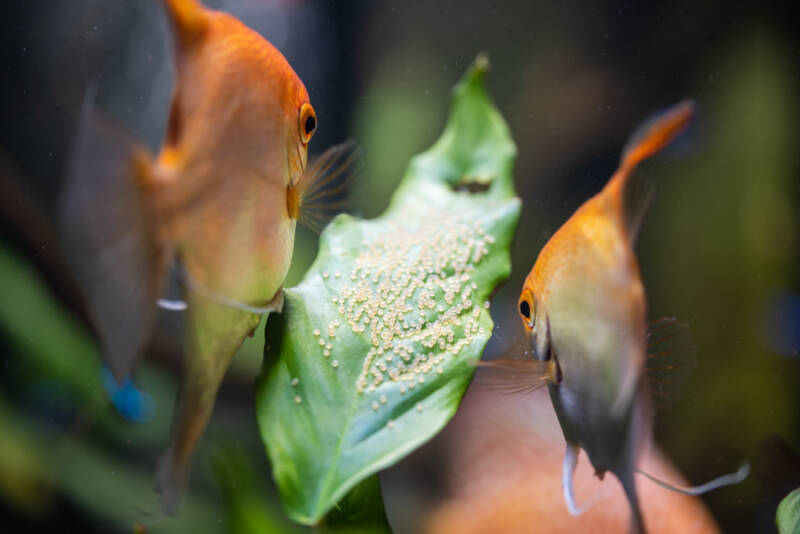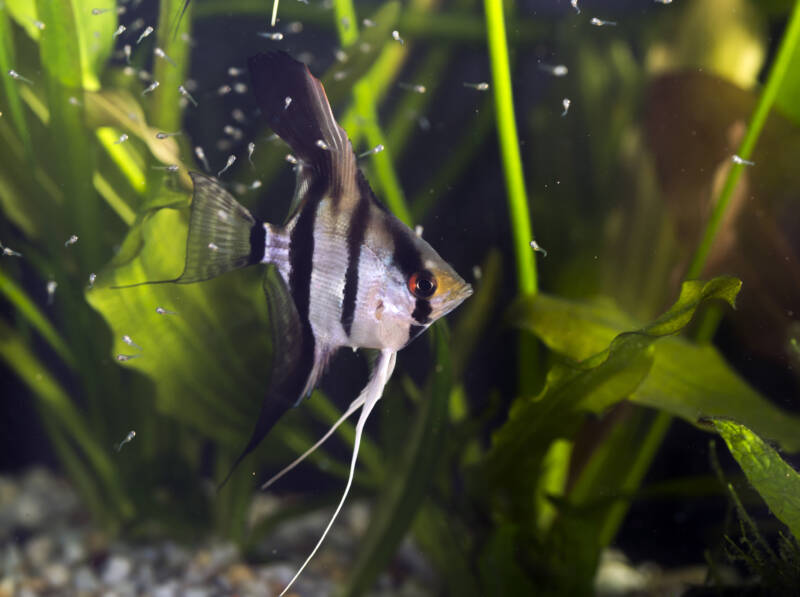Angelfish are one of the most easily recognized species in the aquarium world.
Their lovely, flowing fins and graceful movements in the water, combined with the amazing array of colors and patterns they present, make them one of the more popular aquarium species.

Part of the cichlid family, there are three freshwater angelfish species, all of which hail from South America:
- Angelfish (Pterophyllum scalare)
- Altum angelfish (Pterophyllum altum)
- Leopold’s angelfish (Pterophyllum leopoldi).
These fish will readily breed in captivity, especially the scalare. Below, we address common questions on angelfish breeding, including how to care for the eggs and fry.
[toc]
Angelfish Breeding
Breeding angelfish is a straightforward process. Your fish will naturally pair off into couples, reducing the need to determine which are male or female.
Still, you can note physical differentiation in the papillae; the male’s is thin and pointed while the female’s is blunt and wide.
Angelfish are ready to breed when they are anywhere between five to 12 months old.
Proper care of the fish as they grow into maturity has a big impact on how early they breed and how successful they are.
They can also spawn frequently, as soon as every 12 to 18 days if you immediately separate the parents from the eggs after spawning.
Do angelfish mate for life?
Angelfish are monogamous. They form bonded pairs that will establish and defend a territory.
These bonds last for the lifetime of the fish. Once one of the partners dies, the remaining angelfish does not often seek another.
What are the signs that angelfish are ready to breed?
As your pair of angelfish approach the time to spawn, you may notice behavioral and physical changes.
First, your fish may stay close together and nudge each other.
They may chase other fish away from their selected spawning place and begin to clean the area in preparation for the eggs.
Physically, your female may appear swollen in the abdomen. The best way to see this is to observe her from above.
How do angelfish lay eggs?

In the wild, angelfish lay their eggs on broad-leafed plants, such as the Amazon sword plant.
You can set up your breeding tank with similar plants, or you can install a flat stone on which the female can deposit the sticky eggs.
The benefit to having your fish lay eggs on a removable object is that you can easily take the eggs out of the tank if necessary.
Can angelfish lay eggs without a mate?
A female angelfish can lay eggs when there is no male present.
In this case, the eggs will not be fertilized and will quickly turn white.
Determining Whether or Not the Eggs are Viable
It is fairly simple to determine whether or not you will soon have a tank full of fry.
What color should angelfish eggs be?
Viable angelfish eggs will be very tiny and transparent, with a slight tint of brown or amber.
Non-viable eggs will appear opaque or white.
How can I know if the eggs are fertilized?
In addition to noting the transparent brown color of fertilized eggs, at about 60 hours after the eggs are laid, you may notice the larva developing within them.
Behavior of the Angelfish Parents
Angelfish are decent parents. First, they meticulously clean their breeding site.
Then, once the eggs are laid and fertilized, the parents fan the eggs to aerate them and carefully clean them.
Once the fry hatch, the parents continue to provide care and protection.
Does the male or female angelfish guard the eggs?
Both angelfish will jealously guard their eggs. Their aggression can be directed toward other fish in a community tank or even toward their own mate.
Keep an eye on your tank during this time to determine if certain fish need to be separated for a period.
The male is especially vigilant in guarding the eggs. He will often remain near the newly fertilized eggs to protect and care for them.
Why do my angelfish keep eating their eggs?
While many angelfish are good parents, there are situations that prompt them to eat their eggs. Some common ones are listed below.
Environment
Your angelfish may eat their eggs in response to environmental stressors.
These could be another species getting too close in a community tank or a change in environmental conditions within the tank.
Angelfish are sensitive to changes in ammonia, nitrate, and pH levels, so test your water regularly.
Monitor the temperature and install a heater to keep the temperature consistent.
In addition, keep the filter going, but make sure that the current is mild. Stronger currents can inhibit fertilization, which will lead to white eggs that the parents will consume.
In a community tank, the angelfish parents must constantly guard their eggs from opportunistic predators.
This constant stress can cause your angelfish to consume their eggs.
Experience
Your fish may eat their eggs if they are first-time, young, or inexperienced parents.
If this happens, do not be discouraged. Your fish may simply need another opportunity to be successful.
Try moving them to a separate breeding tank for their next attempt.
If they still show an inclination to eat the eggs, you can separate the parents from the eggs and hatch them yourself.
Noise and Movement
Finally, because of their instinct to guard, angelfish parents may become stressed in response to noises or movement outside the tank.
To prevent this, place the breeding tank in a quiet location and cover the front so that they are not spooked by movement.
Caring for Your Angelfish Eggs
The ideal situation is one where the angelfish parents care for the eggs.
However, there are cases where offspring survivability is increased by removing the eggs.
In this case, you must provide the care that the parents would have given.
What do you do with angelfish eggs?
Set up a separate tank in which you will hatch the eggs. Ensure the water has the same parameters as the community tank and is clean.
Keep the water temperature between 75 to 84 degrees Fahrenheit (24 to 29 degrees C) and the pH between 6 to 8.
Do a partial water change daily and install an air stone, which will help maintain water cleanliness and provide a mild current but will not pose a danger to the tiny fry when they hatch.
Give your fish 12 hours of light per day and use a timer for consistency.
How do you hatch angelfish eggs without the parents?
https://www.youtube.com/watch?v=I-jRQDD2RJQ
Remove the eggs and place them in a separate tank shortly after they are fertilized.
Direct a gentle flow of oxygenated water over the eggs. Add a small amount of methylene blue or acriflavine in the water to help prevent the development of fungus.
Why are my angelfish eggs turning white?
The eggs can turn white for several reasons:
- They are not fertilized
- They develop a fungus
- They have been damaged.
Should I remove angelfish eggs?
If you notice some eggs turning white while others remain transparent, you should remove the white eggs as soon as possible to prevent the spread of fungus.
Rotting eggs left in the tank can impact your water quality and the survivability of the fry.
Caring for Your Angelfish Fry

You can raise angelfish fry in the wiggler and newly free-swimming stages in a tank as small as 10 to 20 gallons.
As the fry grow, however, you will need a larger tank to ensure their optimal, healthy growth.
How long does it take for angelfish eggs to hatch?
Angelfish eggs will hatch within a couple of days after they are laid, usually within 48 to 60 hours.
How many fry do angelfish have?
An angelfish female can lay hundreds of eggs in one spawning, anywhere from 100 to 1,000!
Many of these will not be fertilized, and some may succumb to fungus, be damaged, or be eaten.
How fast do angelfish fry grow?
The growth speed and ultimate size of your angelfish depend a great deal on the conditions you provide.
Make sure the tank is not overcrowded, keep the current gentle, and ensure an adequate amount of nutrient-dense food.
How long does it take for angelfish fry to look like angelfish?
Angelfish fry go through several stages.
Egg Stage
At anywhere from 48 to 60 hours after spawning, the eggs hatch. All of the eggs should hatch almost simultaneously.
Wiggler Stage: During this stage, you will notice the wiggling of fry tails.
The newly hatched fry remain attached to their egg sacs and the surface on which they were spawned for up to seven days. After that, they become free-swimming.
Fry Stage
At this stage, the fry have an elongated shape and oversized eyes.
Two weeks after they become free-swimming (three weeks from the time of spawning), the fry finally begin to take on the typical “angelfish look,” with elongated dorsal and anal fins.
Juvenile Stage
From week three up until six months, the juvenile fish will grow quickly.
They will grow to a length of about 0.7 inches (18 mm) in 10 weeks and just shy of one inch (0.8 inches, 20 mm) in 16 weeks.
By six months of age, they will be anywhere from 4 to 5 inches (10 to 12 cm) in length.
Adult Stage
In six to eight months, the angelfish achieve sexual maturity.
When should I start feeding angelfish fry?
Start feeding the fry when they become free swimming, about seven days after the eggs are laid.
Feed them infusoria in small amounts four or five times per day.
After two days, begin to feed them baby brine shrimp or microworms.
Every two to three weeks, transition them to foods of increasing size, starting with crushed flake food and ending with a standard angelfish diet.
By week 4, they can eat adult food.
How long can angelfish fry go without food?
Angelfish fry can go for up to 12 hours without food, but for their optimum growth and health, feed them multiple times per day.
How many times a day should I feed angelfish fry?
Feed your fry small amounts of food four or five times a day.
Feed only as much as they can consume in a few minutes and remove uneaten food.
Should I separate angelfish fry from parents?
Ideally, the angelfish parents can remain with the fry from the time they are hatched until the time they begin to develop their fins.
If at any point the parents show signs of eating the fry, then they should be removed.
Will angelfish fry survive in a community tank?
Take care when keeping your angelfish fry in a community tank, as many species may view them as a food source.
To prevent this, have some heavily planted areas where the fry can find hiding spaces. Or, install mesh to set aside a “nursery,” where the fry can go but the bigger fish in the tank cannot.
Another idea is to remove all other fish from the community tank except for the parent angelfish and a couple of other peaceful species.
Closing Thoughts
With angelfish, the ideal situation is to place them in a separate breeding tank and let them take care of hatching the eggs and raising the young.
Of course, if you have a breeding pair that is not inclined to provide that nurturing, you will need to take over if you want the fry to grow into adulthood.
Fortunately, this is not an impossible task. With proper care for the eggs, consistent maintenance of water conditions, and an appropriate diet for the developing fry, your chances of raising them to adulthood are very good.
Drop us a message below and tell us your experiences with breeding angelfish.
Do you prefer to keep the eggs with the parents or hatch them yourself?
